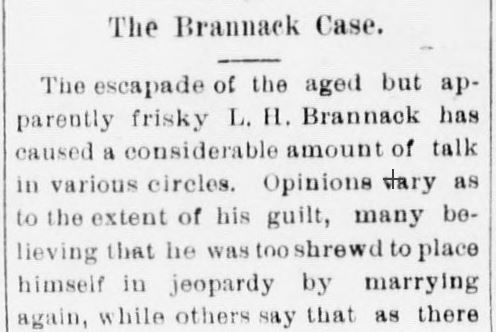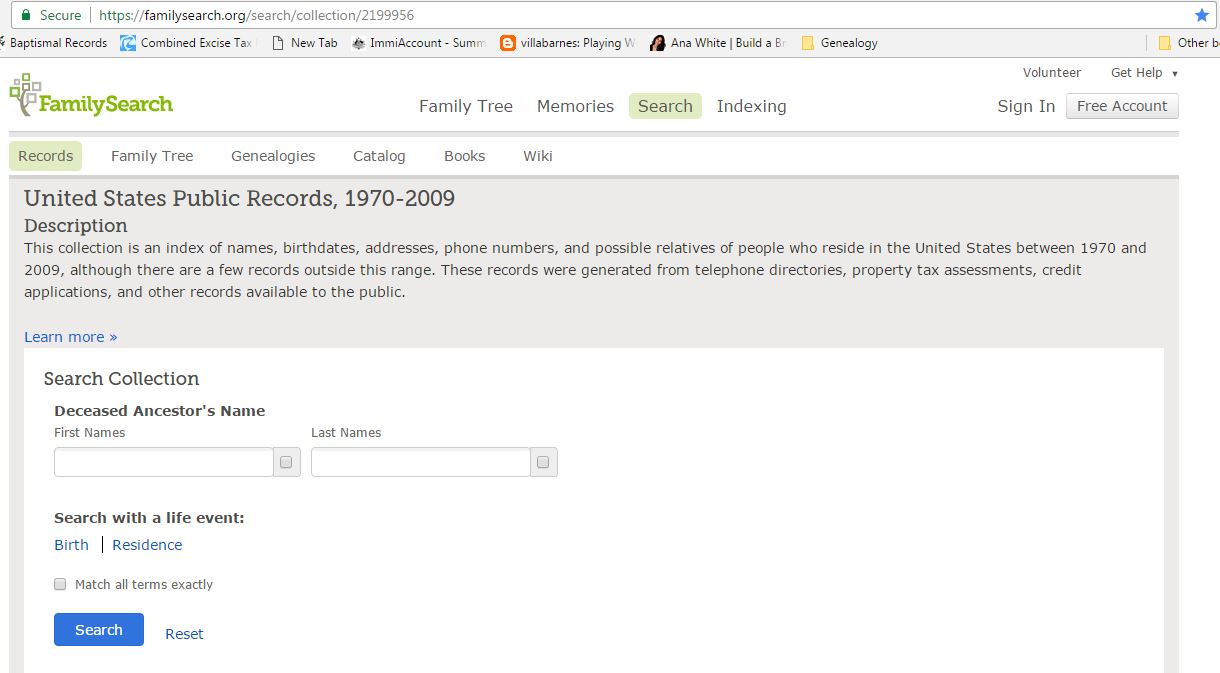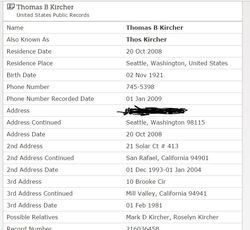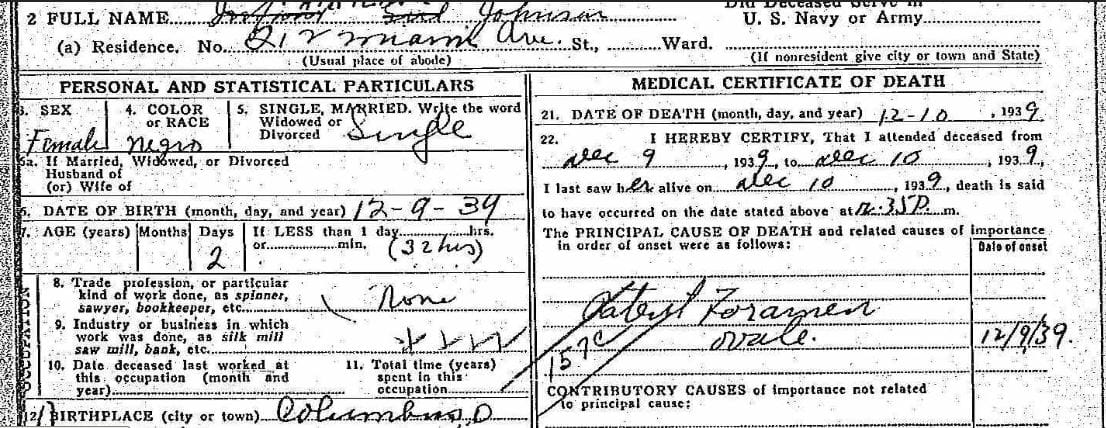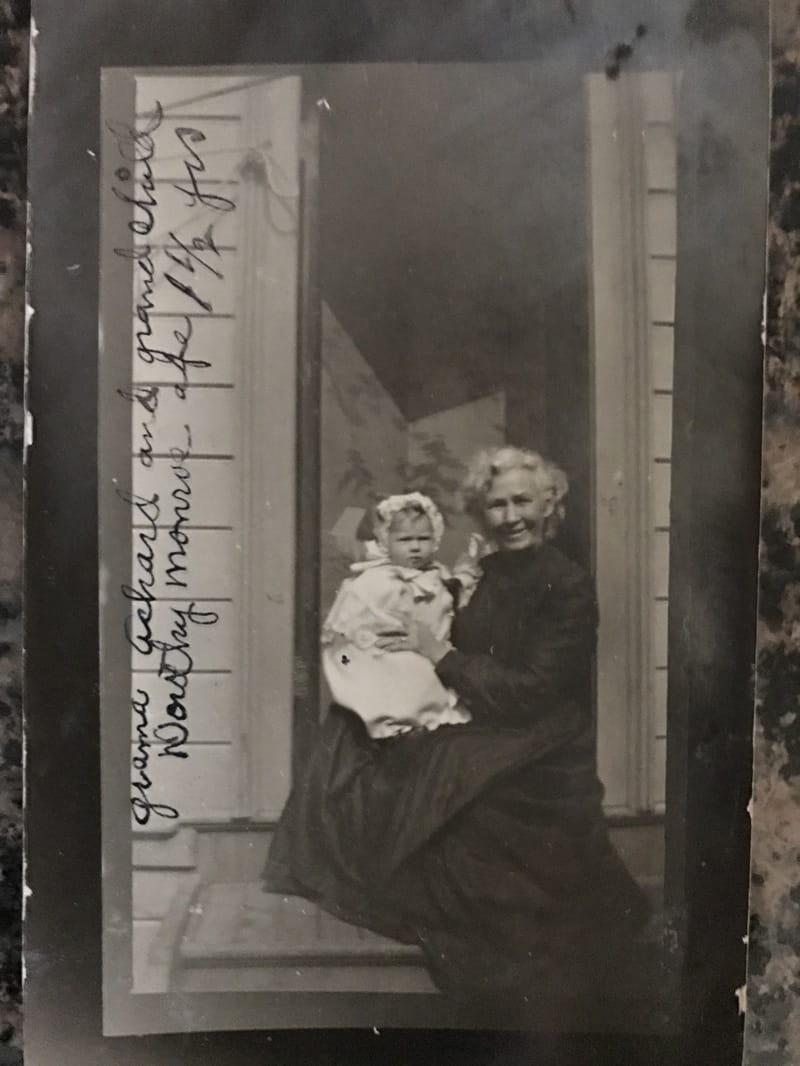|
Last we saw of Lyman Brannack, he had recently settled a law suit in Santa Cruz, California. To catch up, see my blog post, 'Here a Court Case, There a Court Case. Shortly after he settled a lawsuit in Santa Cruz, Lyman decided to take a trip to Pontiac, Michigan, perhaps to see family. In any event, while he was there, he met a Mrs. Hagerman and after a whirlwind courtship they decided to get married, notwithstanding his marriage to Sarah. They were to have been married in Pontiac, but were worried about Mrs. Hagerman’s former husband, so they stole away and were married at Niagara Falls.[1] They left for England. It was there that the new Mrs. Brannack learned that her husband had a legal wife in California. Upon her return from England, she writes to James Briggs, a friend of Lyman Brannack from Santa Cruz: "Mr. James Briggs, Most Respected Sir. – It is with humility and under the most painful circumstances that I attempt to address you as I am the lady upon which Mr. L. H. Brannack practiced so much deception. I married Mr. B. in good faith that he was all he represented himself to be. I was wholly innocent in this matter and while I feel most deeply humiliated yet I committed no sin or crime. "I had been, as I supposed, his legal wife just four weeks to a day, when a letter came from my dear children informing me of the fact that Mr. B. had a living wife. I asked him if the statement were true and he said it was. I never lived with him another hour as his wife after that, but immediately acted upon the advice of my dear daughter and sailed alone by first homeward bound steamer for New York. While I greatly deplore the step I took, yet I feel that I was not to blame. I am very proud and my family has ever stood above reproach and we feel all this very keenly. It has subjected me to much newspaper notoriety which is very mortifying to us all. I feel very sorry for all Mr. Brannack’s people, especially his present wife and his children. It is a most lamentable thing all around. I have returned to my own city and my many friends who crowd around me and say “You have our sympathy, we know you were not to blame.” Now Mr. Briggs, Mr. Brannach told me to write to you and ascertain from you what his reputation and standing had ever been in Santa Cruz, and where he had lived. Of course, after Mr. B. had so grossly deceived me I could not place much confidence in anything he told me and he referred me to you. Did Mr. Brannack own certain property in Santa Cruz, some lots described as follows? "Now, Mr. Briggs, I wish to know if Mr. Brannack was the bona fide owner of these lots when he left Santa Cruz for his trip to Europe and if he still owned them up to July 1st, 1889, and if there was any incumbrance [sic] on the same, and will you please give me your estimate of their value. Mr B. told me to write to you as soon as I arrived home, and said you would give me any information I might wish concerning him. How much is Mr. Brannack considered worth as to property? Please make immediate reply, as I am very anxious to know. Respectfully yours, Frances M. Hagerman[2]" While the former Mrs. Hagerman is “deeply humiliated” she’s also quite curious about just how much money she might have come into on her marriage to the deceptive Lothario whom she wed so quickly. In fact deeds sent by Mrs. Hagerman to the Santa Cruz County Clerk were filed on 24 July 1889. They were deeds for two pieces of property from Lyman Hibbard Brannack to Frances M. Hagerman, dated July 1, 1889 and were made in the city of London, England, describing property in Santa Cruz including several lots in one area, as well as another parcel with a house and improvements. According to the paper, “the entire property deeded by Brannack to Mrs. Hagerman is worth from $2,500 to $3,000. [3] The legal Mrs. Brannack had filed for divorce when she determined that Brannack did apparently go through with the marriage to Mrs. Hagerman.[4] In late August, Mrs. Hagerman-Brannack traveled to Santa Cruz to see “her” property. She sat down for an interview with The Daily Surf, and bore a letter from her attorneys in Michigan, supported by the signatures of many leading citizens of Pontiac. Interestingly, the supportive letter notes that she had been married to Francis Hagerman for a number of years until he became intemperate and abusive of her, but fails to mention that she had spent a term at the Kalamazoo Insane Asylum (where she was at the time the 1880 census was taken) and lectured publically about her time in the asylum.[5] In October, Mrs. Sarah Brannack was granted a divorce on the grounds of bigamy. Mrs. Hagerman relinquished all the deeds to property in Santa Cruz and returned to Michigan.[6] It does not appear that Lyman Brannack returned to the United States, preferring to remain abroad rather than face bigamy charges. Mrs. Sarah Brannack was not quite done with her husband’s family when she received a good portion of real and personal property in October of 1889. In March of the following year, she was sued by Mrs. Sarah A Clapp, Lyman’s daughter, for some personal property. It seems that Lyman Brannack induced Thomas Clapp, Sarah’s husband, to leave a lucrative situation in Tulare county and make his home in Santa Cruz with his wife. Brannack gave the property involved, a stationery engine, two wagons, a buggy, two horses, harness, etc and a colt to Sarah Clapp. Sarah Brannack had received this property originally as part of her divorce settlement from Lyman, but the judge in Clapp v. Brannack ruled in favor of Mrs. Clapp. The paper lamented that the family’s dirty linen was taken to Court to be washed.[7] More next week - Like Father, Like Son - Julia's brother Charles Brannack has problems of his own.... [1] The Daily Inter Ocean, 23 July 1889 “She Married a Married Man” [2] Santa Cruz Daily Surf 26 July 1889, page 3 “Brannack’s Badness” [3] Santa Cruz Daily Surf 25 July 1889, page 3 “Brannack’s Benevolence” [4] Santa Cruz Daily Surf 27 June 1889, page 1 [5] Santa Cruz Daily Surf 5 June 1889, page 3, “Brannack’s Bigamy”; 1880 US Census Year: 1880; Census Place: Kalamazoo, Kalamazoo, Michigan; Roll: 586; Family History Film: 1254586; Page: 199A; Enumeration District: 134; Image: 0399, line 46 [6] Santa Cruz Daily Surf 9 Oct 1889 [7] Santa Cruz Daily Surf 9 Oct 1889, 21 March 1890, page 3
3 Comments
After Julia's marriage to Jacob Wermuth ended, she didn't wait long to remarry. But again, she found herself married to a man old enough to be her father.
Just four days after she appeared in the 1860 census in her father’s house, Julia was married to Percival Monroe.[i] He was about 40, she just 18. The start of the marriage might have been a bit rocky – the following year Percival Monroe was declared insolvent, discharged in San Joaquin county court from the payment of his debts and liabilities.[ii] I have found few records for Julia in the 1860s. It is curious to me that while she and Percival were married in 1860, the first child I can find from their union was not born until 1873. And while the marriage may have lasted twenty-some years, it does not appear that it was a bed of roses. In 1883, Percival was arrested at Stockton on a charge of libel preferred by his divorced wife, Julia A. Monroe.[iii] This would not be Julia’s last foray into the court system. The following year, she sued her father. Before Hester Withee Brannack’s death in 1869, Lyman and Hester had engaged in some real estate transactions in which property was deeded to Hester. After Hester’s death, Julia and her siblings, as heirs of Hester, brought suit against Lyman to inherit certain parcels. The court ruled, however, that the parcels in question were not Hester’s separate property, and instead belonged to Lyman.[iv] Nor was this Lyman’s only brush with a court. After Hester died, he married a woman named Sarah. They lived in Santa Cruz, California where he was on the city council[v], resigning 11 March 1885.[vi] He was involved in various ventures including shipping and lumber in Santa Cruz. A lawsuit was brought against him in 1889 by Alfred H. Fitch for the non-fulfillment of a contract to deliver shingles. An entire trial was held, Brannack called many witnesses, the case went to the jury which deliberated for a short while when they received word that Brannack and Fitch had settled, Fitch agreeing to withdraw the suit and pay the court costs, and Brannack agreeing to donate to the YMCA $150, a sum about equal to the court costs.[vii] Much as Julia struggled to maintain a happy marriage with Jacob Wermuth and Percival Monroe, her father, Lyman’s marriage to his second wife Sarah might not have been a bed of roses. More next week about Lyman’s 1889 trip to Pontiac, Michigan where he makes a new friend. [i] Ancestry.com. Marriage records of San Joaquin County, California [database on-line]. Provo, UT: The Generations Network, Inc., 2004. Original data: Marriage records of San Joaquin County, California : August, 1850-December, 1865. Stockton, Calif.: The Society, 1969., “Register of marriages no. 1”, page 20 accessed through Ancestry.com 30 January 2013 [ii] Stockton Daily Argus, 14 May 1861, accessed through Newspaper Abstracts, http://www.newspaperabstracts.com/link.php?id=31769, 30 January 2013 [iii] San Francisco Bulletin, 7 March 1883, page 1, “State News in Brief”, accessed through Genealogybank.com 30 January 2013 [iv] The Pacific Reporter Volume 4, page 488, West Publishing Company, “Brannock v. Monroe”, accessed through Googlebooks 30 January 2013 http://books.google.com/books?id=3ek-AAAAIAAJ&pg=PA488&lpg=PA488&dq=Hester+Brannack+the+pacific+reporter&source=bl&ots=fZZp96WxFY&sig=iSNFOCy5yt3-g8ilBclNmCmrUwo&hl=en&sa=X&ei=g7YJUY_5NOGjigL-0oCgDQ&ved=0CC4Q6AEwAA#v=onepage&q=Hester%20Brannack%20the%20pacific%20reporter&f=false [v] Santa Cruz Local News Index, 15 April 1884, “Elected to City Council”, http://www2.santacruzpl.org/history/oldnews/full.php?record=1835&term=brannack, accessed 30 Jan 2013 [vi] Website – City of Santa Cruz Common Councils and Mayors, 1876-1906, http://scplweb.santacruzpl.org/history/gov/sc2.shtml accessed 30 Jan 2013 [vii] Santa Cruz Daily Surf, 12 February 1889, page 1 More of the continuing saga of Julia. Newspaper accounts led me to her stormy first marriage… Jacob Alexander Wermuth and Julia Ann Brannock were married in San Joaquin County 1 January 1857.[1] Julia was 14, and Jacob was about 20 years her senior. Son, Millard, was born just ten months later.[2] Two days before her second wedding anniversary, Julia ran off with another man. The Weekly Stockton Democrat tells the story: "ABDUCTION of a WIFE -- On Thursday, the 30th ult., a man by name of HANNA, who had been employed on a ranch near Henderson's, on the Mokelumne, eloped with the wife of J.H. WORMUTH. HANNA had formerly been suspected of improper intimacy with WORMUTH's wife, from which cause he had returned her to her parents, with whom she lived until a reconciliation took place, when she returned to her husband. "On Thursday, the 30th ult., upon pretext of visiting her parents, she left home but did not return at night, which fact created some suspicion. On the following morning her husband went in search of her, and learned to his surprise that she had not visited her parents, and that the latter knew nothing of her whereabouts. "HANNA, who has for several weeks past resided in this city, obtained a buggy from the Centre St. Livery Stables on Friday, and in company with WORMUTH's wife arrived in town as the boat was leaving for San Francisco, upon which they took passage, registering their names as Mr. & Mrs. BROWN. "The father of the runaway wife, Mr. L.H. BRANNOCK, a gentleman much esteemed by his neighbors, arrived in the city yesterday, and obtained a warrant for the recovery of about $200 in coin and a quantity of jewelry in the possession of his daughter, and left on the boat last evening. "The marriage of Mr. WORMUTH with his wife occurred about 2 years since, at which time she was 14 years of age. They lived happily until the appearance of HANNA upon her father's ranch as a hired man, when she repeatedly gave evidence of improper intimacy with HANNA. "A child about a year old, the issue of the marriage, is left motherless and disgraced at her father's house; while the husband, a young man of intelligence and much respected by all who know him, has been made miserable through the heartless desertion of his wife. "HANNA is a Canadian, with nothing prepossessing in his personal appearance, and uneducated; and while wanting in everything that elevates the man, his conduct has been uniformly that of one who would stoop to whatever was low and debasing in human character to accomplish the objects of his animal nature. Although the laws do not hold criminally responsible for the part he has taken in the abduction of a wife, it is to be hoped they may prove effectual in securing the return of the property, in obtaining which he undoubtedly performed the part of an accomplice, in order that his designs might be the more successfully carried ou"t.[3] The San Francisco Bulletin continues the story on January 12: "More of the Abductor of the Girl-Wife - The San Joaquin Republican says: One Hugh Hanna was brought before Justice Brown, at Stockton, on 10th January, on charges of stealing a silver watch, valued at $16, and $16.50 in coin, from Mr. Wormuth, on the Mokelumne river. Hanna, who is a Canadian, had been at work for the father of a Mrs. Wormuth, a respectable gentleman named Brannock, and succeeded in seducing his daughter, a girl of some fourteen or fifteen years. She was married to Mr. Wormuth, who discovered her intimacy with the fellow even after marriage. A separation ensued, but the husband was induced to receive the girl back. About a week since, the wife eloped with Hanna, and was pursued and overtaken by the father of the young woman about 150 miles south of San Francisco. They were taken to Stockton, and the foolish child-wife was saved from the shame, disgrace and certain ruin of living with Hanna, by being re-admitted to her father's house. Unfortunately, the theft of Mr. Wormuth's property could not be proved upon the accused, and the District Attorney was compelled to enter a nolle prosequi. He gave the fellow a severe lecture, concluding by advising the rascal to leave these parts. If he is wise, he will heed the advice."[4] In April of 1859, Jacob Wermuth was granted a decree of divorce, the allegation of desertion being sustained.[5] On the 12th of September, 1859, Fred Wermuth was born.[6] Given the timing of his birth in relation to Julia’s elopement with Hugh Hanna and her divorce from Jacob Wemuth, it may give a clue to suspicions about his paternity that Fred lived with Julia, and Millard stayed with Jacob. More next week… [1] Western States Marriage Index, Jacob Alexander Wermuth and Julia Ann Brannock, San Joaquin, Vol M, pg 85 http://abish.byui.edu/specialCollections/westernStates/westernStatesRecordDetail.cfm?recordID=1487551, accessed 30 January 2013 [2] California death index, Millard W. Wermuth, Birthdate 4 Nov 1857, Death Date 30 Dec 1954, Source Citation: Place: Sacramento; Date: 30 Dec 1954. accessed through Ancestry.com 30 January 2013 [3] The Weekly Stockton Democrat, Sunday 9 January 1859, http://archiver.rootsweb.ancestry.com/th/read/casanjoa/2006-03/1143565203, accessed 30 Jan 2013 [4] “More of the Abductor of the Girl-Wife,” The San Francisco Bulletin, 12 January 1859, page 3, column 4, from GenealogyBank.com accessed 15 January 2017 [5] The Weekly Stockton Democrat, 24 April 1859, http://www.newspaperabstracts.com/link.php?id=25303 accessed 30 January 2013 [6] California death index, Millard W. Wermuth, Birthdate 12 Sep 1859, Death Date 3 Apr 1950, Source Citation: Place: Santa Cruz; Date: 3 Apr 1950, Social Security: 548073697. accessed through Ancestry.com 30 January 2013 Lately there has been a great deal of concern over a website, FamilyTreeNow which includes on their website records on living people. This information includes birth dates or birth year or age as well as addresses and possible relatives. The data on this site has been compiled from various public records including property transfers, property tax payments, voter registrations, utility bills and others. The consensus is that one must opt out of this website in order to remove their private information from the web. The biggest complaint seems to be that all this information is available for free. Some believe that FamilyTreeNow should be shut down for providing this information. News flash. One of the most popular and legitimate sites used by genealogists, FamilySearch has the exact same kind of information. The FamilySearch United States Public Records 1970-2009 allows you to search by name (and residence if you want to narrow it down.) Here's the link - https://familysearch.org/search/collection/2199956 I searched for my a man named Thomas Kircher. He passed away in August 2008, so I'm showing the screen shots below of the results of my search. Note, I am not signed in to any account at FamilySearch. This is a totally public, free and anonymous search. You can see very clearly it lists his exact birthday. If I click on the icon under the word "View" I get the following additional information. You can see that in addition to Thomas' exact birth date, FamilySearch has also given me three addresses for him, including dates when those addresses were collected. A phone number is also provided. And finally I'm given the names of two possible relatives. The information from FamilySearch is similar to what could be found on FamilyTreeNow, and comes from similar public records.
Thomas and the two possible relatives displayed on this record are all deceased so I'm comfortable showing these screenshots. But trust me, the kinds of information shown is available for living people as well. I have not found myself on this database, but I've seen plenty of people I know who are alive and kicking and their details are out there on FamilySearch, one of the most trusted websites used by genealogists. These public records are out there, and clicking the "Opt Out" button on FamilyTreeNow won't do much to hide your details from someone looking for you. And I haven't seen any button on FamilySearch allowing you to opt out. ComputerWorld has an article about going further to remove your details from the interenet at http://www.computerworld.com/article/2849263/doxxing-defense-remove-your-personal-info-from-data-brokers.html. It may help, but we're in the digital age and this kind of public information is never going to disappear. A continuation from last week, as I begin to research the mysterious Mrs. J. A. Achard/Mrs. Shiland of 415A Third Street, San Francisco, who may have had something to do with the death of Sarah Ahern, wife of my great-great uncle, Jimmy Ahern.
The easiest place to begin looking for Julia was the 1900 US Federal census for San Francisco. I found her right away, living on Castro Street. She was 58, divorced, born in Michigan, had given birth to 6 children, all of whom were still alive, and she resided with her 27-year-old son, David Monroe and his wife, Nellie. Although no occupation is listed for Julia, David is a bartender.[1] The city directory for San Francisco was able to shed a little more light on Julia, however. In the 1901 San Francisco city directory, Mrs. Julia A Achard, residing at 415A 3d is a midwife.[2] But now that I had her son’s name, David Monroe, born about 1873 in California, I thought I’d backtrack a bit on Julia and see what more I could find. The 1880 census gave me a few more names in Julia’s life. In Elkhorn Township, San Joaquin County, Julia Monroe lives with her husband, Percival Monroe and their four children, David, twin daughters Ida and Ada, aged 4, and a son Lewis, aged 1. Also in the house are three farm laborers – Fred Wermuth, the 20-year-old step-son of Percival Monroe, and Harrison and Charles Branack, ages 27 and 21, brothers of Julia Monroe.[3] Looks like I’ve found Julia’s maiden name, Branack, and perhaps another married name for her, Wermuth, as well as five of the six children counted on the 1900 census. Ten years earlier, Julia and P Monroe live in Elliot Township in San Joaquin, with a 10-year-old boy, Fred Monroe, likely to be the same Fred Wermuth as in 1880. Three presumably unrelated males, perhaps farm laborers, live in the house at the same time.[4] Elsewhere in San Joaquin, in O’Neal Township, resides L.H. Brannock, a 52-year-old male farmer, L.M. Brannock, a 26 year old female, born in Ohio, Sarah Brannock, age 19, H. Brannock, a 17-year-old male, (could be Harrison from the 1880 census), Chas Brannock, age 12 and Estella Brannock, age 9, the last two born in California, plus three farm laborers.[5] The Wermuth part of the equation gets a little foggy – a Wermuth family seems to appear twice in the census. On a census taken 10 June 1870 in Elkhorn Township appear 44-year-old J.A. Wormeth, born in New York, 46-year-old Eliza Wormeth born in Arkansas and 12-year-old Willard Wormeth born in California.[6] On a census taken 5 August 1870 in Stockton, appear J.V. Wormuth, age 46, Eliza Wormuth, age 46 and Millard Wormuth age 12, all with the same birthplaces as in the Elkhorn Township listing.[7] No other Wermuths (or variants) appear in San Joaquin in 1870. Rolling back another decade, the 1860 census for Elkhorn Township taken on the 18th of July gives a household full of Brannacks – Lyman H, Hester A, both 42, born in New York and Maine, respectively (the same parental birthplaces listed for Julia Achard in 1900), Julia A, age 18, Emily, 13, Sarah, 9, Harrison 7, Charles 2, as well as Frederick M. Wermuth, age 10/12, and four farm laborers.[8] Alex, Elizabeth and Millard Wermuth are also living in Elkhorn Township.[9] The census provided some dry facts – names, ages, birthplaces, occupations. Now I had my “cast of characters.” It was when I got into the newspapers that my fascination with Julia took shape… More next week… [1] US Census of 1900, Year: 1900; Census Place: San Francisco, San Francisco, California; Roll: 103; Page: 8A; Enumeration District: 0134; FHL microfilm: 1240103, lines 34-36, accessed through Ancestry.com 30 January 2013 [2] Crocker-Langley Directory for San Francisco, 1901, page 164 [3] US Census of 1880, Year: 1880; Census Place: , San Joaquin, California; Roll: 80; Family History Film: 1254080; Page: 195C; Enumeration District: 104; household of Percival Monroe, lines 19-27, accessed through Ancestry.com 30 January 2013 [4] US Census of 1870, Year: 1870; Census Place: Elliot, San Joaquin, California; Roll: M593_86; Page: 79B; Image: 162; Family History Library Film: 545585, lines 12-17 accessed through Ancestry.com 30 January 2013 [5] US Census of 1870, Year: 1870; Census Place: Oneal, San Joaquin, California; Roll: M593_86; Page: 102B; Image: 208; Family History Library Film: 545585, lines 23-31 accessed through Ancestry.com 30 January 2013 [6] US Census of 1870, Year: 1870; Census Place: Elkhorn, San Joaquin, California; Roll: M593_86; Page: 56A; Image: 115; Family History Library Film: 545585, lines 38-40, accessed through Ancestry.com 30 January 2013 [7] US Census of 1870, Year: 1870; Census Place: Stockton, San Joaquin, California; Roll: M593_86; Page: 177A; Image: 357; Family History Library Film: 545585, lines 13-15, accessed through Ancestry.com 30 January 2013 [8] US Census of 1860, Year: 1860; Census Place: Elkhorn, San Joaquin, California; Roll: M653_64; Page: 100 (penned); Image: 354; Family History Library Film: 803064, lines 15-26, accessed through Ancestry.com 30 January 2013 [9] US Census of 1860, Year: 1860; Census Place: Elkhorn, San Joaquin, California; Roll: M653_64; Page: 973; Image: 359; Family History Library Film: 803064, lines 37-39, accessed through Ancestry.com 30 January 2013 Have you ever had difficulty reading the cause of death on a death certificate? I share your pain (and so do the thousands[1] of other genealogists reading this post.) Doctors learn a number of things in medical school, but Palmer penmanship is not one of them. Did you know there’s a potential solution out there for your dilemma? Health statisticians have created the “International Classification of Diseases” lists. While these lists were created to help public health authorities to understand what kinds of maladies were impacting their constituencies, they’re a boon for helping genealogists decipher what the doctor wrote on Grandpa’s death certificate. The original list of disease classification was created in 1893 and has been revised approximately every ten years since. A link to these lists can be found at http://www.sb-genealogy.org/files/International_Classification_of_Diseases.pdf. When you look at a death certificate, often in the area where the cause of death is written, you might see a numerical code, generally two to three digits, sometimes followed by a letter. In the image below, the 1939 death certificate of two-day-old Patricia Johnson, the first word of the cause of death has been somewhat obscured by the code, “157c.” I can make out two words, “… foramen ovale,”[2] (which I recall from my high school biology course 40 year ago has something to do with the heart.) When I look at the disease classification list for 1938 (the most current list in existence for the year of her death), 157c is described as “congenital malformation of heart.” Being able to look up the code has given me a pretty clear picture of what happened to this wee baby. Not every death certificate shows the numerical code right next to the cause of death. In the following 1936 death certificate for Elizabeth Doyle,[3] the cause of death appears on the right-hand side of the page, approximately halfway down. I think I can read “subacute nephritis.” At the very top of the page on the left-hand side above the county of death appears the number 130, which according to the 1929 disease classification list refers to “acute nephritis.”[4] 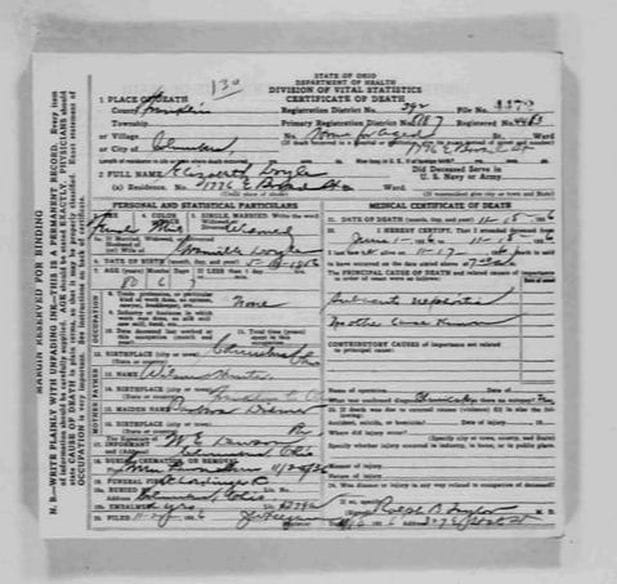 1936 death certificate of Elizabeth Doyle. See endnote for source citation. 1936 death certificate of Elizabeth Doyle. See endnote for source citation. Three takeaways from this lesson –
1. Bookmark this website. If you’re like me, you’ll want to refer to it often. 2. Use the most recent disease classification list taken before the year of death on the certificate. If the certificate you're working with is one of the "update" years, look at that one as well as the prior one. The statistician marking your death certificate may have been working with an old list, not the most up-to-date one. 3. If you don’t see the code near the cause of death, look around. It’s probably there, hiding in plain sight. [1] “Please, oh please,” says this hopeful blogger. [2] "Ohio Deaths, 1908-1953," database with images, FamilySearch (https://familysearch.org/ark:/61903/1:1:XZBK-982 : 8 December 2014), Patricia Johnson, 10 Dec 1939; citing Columbus, Franklin, Ohio, reference fn 72017; FHL microfilm 2,023,770. Accessed 3 January 2017 [3] "Ohio Deaths, 1908-1953," database with images, FamilySearch (https://familysearch.org/ark:/61903/1:1:XZDJ-QQS : 8 December 2014), Elizabeth Doyle, 18 Nov 1936; citing Columbus, Franklin, Ohio, reference fn 68990; FHL microfilm 2,022,732. Accessed 3 January 2017 [4] The 1929 disease classification list includes “130 - Acute nephritis,” “131 - Chronic nephritis,” and “132 - Nephritis, not stated to be acute or chronic.” There does not appear to be a distinct code for “subacute nephritis.” More than ten years ago while researching the death of my great-great uncle’s wife, I stumbled upon a character who has fascinated me ever since. I’ve researched Julia and her family in newspapers, census records, city directories and coroner’s inquests, and each story I find makes me want to dig deeper and learn more… I originally wrote the post below as part of an article I aspired to publish in a Calfornia genealogical society periodical in the hopes that one of Julia's descendants might stumble upon it and want to connect with me. However the publisher felt the proposed article (at 5000+ words) was too long and I struggled with editing out any of the many good parts, so it was never published. Two days ago, however, I had the most delightful email from Linda, Julia's great-great granddaughter who found the family tree I posted about Julia on Ancestry.com. We've had a couple of long phone conversations and she even sent me a picture of Julia. Linda is happy to have this information about Julia and her family out there,warts and all. In the coming weeks, as my Sunday Stories blog posts, I will run all the sections of those 5000+ words I wrote. Enjoy! I first met Julia in 1901. Even then, I wasn’t sure what her name was. It might have been Achard, it might have been Shiland. It took me years to figure out which was the right one – and why there might have been any question in the first place. I encountered Julia from the newspaper articles about Sarah Ahern’s death.[1] “The Bulletin says ‘With her lips sealed as to who gave her the medicine which caused her death, Mrs. Sarah Ahern of Tiburon died suddenly Friday. The circumstances surrounding the case are such that arrest may follow the investigation made by the coroner.’” Before her death, Sarah “…would say nothing other than that a friend had given her medicine. After her death, however, Mr. Ahern found a small box and some cards bearing the name of Mrs. J.A. Achard of 415a Third Street, San Francisco. Coroner Eden was notified and held an inquest. The facts as above stated were brought out, and Dr. W.J. Wickman, the coroner's physician made an autopsy, finding that the woman was a victim of malpractice and that death was due to septicema. James Ahern, the husband, remembered seeing Mrs. Shiland visiting his wife. Mrs. Shiland was called as a witness, and was put through a rigid examination. She admitted calling on Mrs. Ahern, but denied giving her any medicine or attending her. This is the second time she has been called before the coroner's jury. Three years ago she was a witness in a San Francisco case. The jury was given the case and returned a verdict that Mrs. Ahern came to her death from blood poisoning, due to causes unknown.”[2] Another article indicated that the box contained pills, and that the doctors who treated Sarah after Mrs. Achard left “stated their belief that she was suffering from the effect of medicine given her by a malpractitioner.”[3] What were these pills? I suspected that Sarah might have committed suicide. Her fifteen-month-old daughter, Agnes Jane, had drowned February 15, 1900, after wandering into a tidal lagoon behind the family home.[4] Could Sarah have secured some pills which would put an end to her personal grief and perhaps her guilt? Perhaps if I could find Mrs. J.A. Achard I might learn something about what those pills might have been. More next week… [1] For more about Sarah Ahern, see my blog posts from January 2016, “Suffer the Little Agnes Ahern,” “One Loss Leads to More,” and “Discover Leads to Understanding” at http://www.mkrgenealogy.com/searching-for-stories-blog/archives/01-2016 [2] The Marin Journal, 16 May 1901 [3] San Francisco Chronicle 12 May 1901, page 11 “Died of Septicaemia” [4] San Francisco Call, 16 February 1900, page 4, “Mother Finds the Body of Her Child” 4, “Mother Finds the Body of Her Child” |
AuthorMary Kircher Roddy is a genealogist, writer and lecturer, always looking for the story. Her blog is a combination of the stories she has found and the tools she used to find them. Archives
April 2021
Categories
All
|
